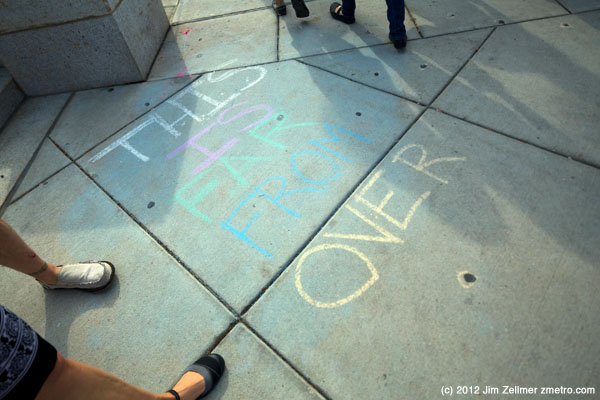Vinod Khosla says technology will replace 80 percent of doctors — sparks indignation
Accomplished Silicon Valley investor Vinod Khosla likens modern healthcare to witchcraft, and says technology will replace 80 percent of doctors.
His views, offered up in a talk last week in San Francisco, sparked outrage from doctors.
Khosla is a co-founder of Sun Microsystems, and made his mark as one of the most successful investors during the Internet boom of the late 1990s with his backing of networking equipment companies.
He made the healthcare comments during the Health Innovation Summit, hosted by Rock Health, a seed accelerator company focused on health care. Khosla’s keynote talk is nicely summarized by Davis Liu, a doctor who attended the event.
In his comments, Khosla said that medical tradition has mired doctors in voodoo-like practices.
Khosla said that machines, driven by large data sets and computations power, not only would be cheaper, more accurate and objective, but better than the average doctor. To get there, the level of machine expertise would need to be in the 80th percentile of doctors’ expertise, he said.
And then Khosla slipped in some hyperbole: “Eventually, we won’t need the doctor,” he said, according to another report of the talk.
The audience reportedly went silent when Khosla challenged anyone to disagree with him. However, after the talk, critics reading about his talk took to comments at the bottom of Liu’s piece, and elsewhere, including Twitter. Columbia University-trained doctor Bijan Salehizadeh said he was “nauseated” by Khosla’s remarks.
Khosla also upset some doctors by saying that disruption in healthcare is likely to be driven by entrepreneurs outside of the industry, rather than by specialists within.
Organic food no healthier than non-organic: study
Organic produce and meat typically isn’t any better for you than conventional varieties when it comes to vitamin and nutrient content, according to a new review of the evidence.
But organic options may live up to their billing of lowering exposure to pesticide residue and antibiotic-resistant bacteria, researchers from Stanford University and the Veterans Affairs Palo Alto Health Care System found.
“People choose to buy organic foods for many different reasons. One of them is perceived health benefits,” said Dr. Crystal Smith-Spangler, who led the new study.
“Our patients, our families ask about, ‘Well, are there health reasons to choose organic food in terms of nutritional content or human health outcomes?'”
Saturday Madison Photos: Raging Grannies, Old Chevy, Tammy & Tommy, Ayn Rand, “This is Far from Over”

The Raging Grannies performed “Drones in the Sky” among other tunes.



I saw a number of Tammy and Tommy stickers. Two men sporting Tommy stickers walked briskly by as I purchased tomatoes. They encouraged each other to move quickly as the “Tammy people were on this corner”.
Everything You Think You Know About China Is Wrong Are we obsessing about its rise when we should be worried about its fall?
The disconnect between the brewing troubles in China and the seemingly unshakable perception of Chinese strength persists even though the U.S. media accurately cover China, in particular the country’s inner fragilities. One explanation for this disconnect is that elites and ordinary Americans remain poorly informed about China and the nature of its economic challenges in the coming decades. The current economic slowdown in Beijing is neither cyclical nor the result of weak external demand for Chinese goods. China’s economic ills are far more deeply rooted: an overbearing state squandering capital and squeezing out the private sector, systemic inefficiency and lack of innovation, a rapacious ruling elite interested solely in self-enrichment and the perpetuation of its privileges, a woefully underdeveloped financial sector, and mounting ecological and demographic pressures. Yet even for those who follow China, the prevailing wisdom is that though China has entered a rough patch, its fundamentals remain strong.
How Google and Apple’s digital mapping is mapping us
Which brings us to the core of the matter. It can be easy to assume that maps are objective: that the world is out there, and that a good map is one that represents it accurately. But that’s not true. Any square mile of the planet can be described in an infinite number of ways: in terms of its natural features, its weather, its socio-economic profile, or what you can buy in the shops there. Traditionally, the interests reflected in maps have been those of states and their armies, because they were the ones who did the mapmaking, and the primary use of many such maps was military. (If you had the better maps, you stood a good chance of winning the battle. The Ordnance Survey’s logo still includes a visual reference to the 18th-century War Department.) Now, the power is shifting. “Every map,” the cartography curator Lucy Fellowes once said, “is someone’s way of getting you to look at the world his or her way.” What happens when we come to see the world, to a significant extent, through the eyes of a handful of big companies based in California? You don’t have to be a conspiracy theorist, or an anti-corporate crusader, to wonder about the subtle ways in which their values and interests might come to shape our lives.
A manifesto for the new rules on human capital
I recently spoke at the World Strategy Forum event in Seoul, where the theme was “The new rules: reframing capitalism”. Predictably, the discussion focused on global financial infrastructure. But, as one of the few non-economist speakers, I instead argued that employment/unemployment is even more affected by the changing nature of work – and the wildly accelerating effectiveness of technology, which is encroaching on activities that employ tens of millions of people, especially in the developed world.
This is, I believe, in the mid to long term, both the number one problem and the number one opportunity for businesses and wider society. But the specifics of what follows were triggered by the debate at the event and were eventually encapsulated in what I grandly call: “A human capital development manifesto at the enterprise and national government level”.
- Maximising what I’ll call “gross domestic development” of the workforce, driven at the level of the individual enterprise, is the primary source of growth, productivity, wealth creation and social stability.
- Development of “human capital” should always be the top priority – albeit a commandment all too often honoured in the breach. But this is an inescapable imperative in an age in which imaginative brain-work is de facto the only plausible survival strategy for individual enterprises of consequence and higher-wage nations in their entirety. Generic “brain-work”, the traditional and dominant white-collar activities that now employ the bulk of us, is increasingly undertaken by exponentially enhanced artificial intelligence applied at ever increasing speed.
The Coming Civil War over General Purpose Computing
The closest approximation we have for such a device is a computer with spyware on it— a computer that, if you do the wrong thing, can intercede and say, “I can’t let you do that, Dave.”
Such a a computer runs programs designed to be hidden from the owner of the device, and which the owner can’t override or kill. In other words: DRM. Digital Rights Managment.
These computers are a bad idea for two significant reasons. First, they won’t solve problems. Breaking DRM isn’t hard for bad guys. The copyright wars’ lesson is that DRM is always broken with near-immediacy.
DRM only works if the “I can’t let you do that, Dave” program stays a secret. Once the most sophisticated attackers in the world liberate that secret, it will be available to everyone else, too.
Second, DRM has inherently weak security, which thereby makes overall security weaker.
Certainty about what software is on your computer is fundamental to good computer security, and you can’t know if your computer’s software is secure unless you know what software it is running.
Poll: 54% of Americans like the TSA
Despite recent negative press, a majority of Americans, 54%, think the U.S. Transportation Security Administration is doing either an excellent or a good job of handling security screening at airports. At the same time, 41% think TSA screening procedures are extremely or very effective at preventing acts of terrorism on U.S. airplanes, with most of the rest saying they are somewhat effective.
My first reaction was that people who don’t fly — and don’t interact with the TSA — are more likely to believe it is doing a good job. That’s not true.
How Paperbacks Transformed the Way Americans Read
Half a century before e-books turned publishing upside down, a different format threatened to destroy the industry.
Here’s a little perspective: In 1939, gas cost 10 cents a gallon at the pump. A movie ticket set you back 20 cents. John Steinbeck’s The Grapes of Wrath, the year’s bestselling hardcover book, was $2.75. For a nation suffering 20 percent unemployment, books were an impossible expense.
But in just one day, Robert de Graff changed that. On June 19, 1939, the tall, dynamic entrepreneur took out a bold, full-page ad in The New York Times: OUT TODAY—THE NEW POCKET BOOKS THAT MAY TRANSFORM NEW YORK’S READING HABITS.
The ad was timed to coincide with the debut of his newest endeavor, an imprint called Pocket Books. Starting with a test run of 10 titles, which included classics as well as modern hits, de Graff planned to unleash tote-able paperbacks on the American market. But it wasn’t just the softcover format that was revolutionary: De Graff was pricing his Pocket Books at a mere 25 cents.